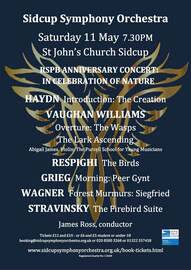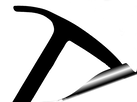
This Saturday's concert with Sidcup Symphony Orchestra, 7.30pm at the Church of St John the Evangelist, Sidcup, is a special event celebrating 50 years of the UK's Royal Society for the Protection of Birds local groups.
Programming a concert of 'bird music' superficially is easy. There is a corncopia of great music inspired by or named after birds and nature scenes, however we wanted to avoid a simple parade of woodwind trills and other musical clichés, and explore music and birds beyond only the literal. The concert starts therefore with the beginning of Haydn's The Creation - his 'representation of chaos' before any life existed. We move without a break into Vaughan Williams' The Wasps - music of suitably furious speed, and apt: after all, without insects, there would be no birds or other living creatures either, humans included.
Respighi's The Birds is a tribute to composers of the 17th- and 18th-centuries, offering a dove, hen, nightingale and cuckoo of stylisted elegance - more Petit Trianon than the wild nature - an Enlightenment with wings. The first half ends with Vaughan Williams' serene The Lark Ascending, inspired by Meredith's eponymous poem, with solo violinist Abigail James from The Purcell School for Young Musicians.
The concert's second half moves from the classical and idyllic to the Romantic and mythological. After Grieg's evocation of 'Morning' from his incidental music to Ibsen's play Peer Gynt, we play Wagner's Forest Murmurs arranged from Siegfried, the third music drama of his Ring Cycle. In this scene, Siegfried is guided by a wood-dove to find Faftner, the fratricidal giant-turned-dragon guarding the Nibelung, which must be returned to the Rhinemaidens to redeem the world. Every bar is full of symbolism, reminiscence - including of Siegfried's parents - and prediction of the future - including his death and of the end of the world. Musically Wagner also created a forest evocation that influenced his generation of composers and far beyond, including endless films.
For the final work, Stravinsky's The Firebird, we move from Romanticism to musical Impressionism and early Modernism. The Firebird is a majestic creature of Slavic mythology: in Fokine and Benois ballet scenario, she is half-woman, half-bird. Amazed by her beauty, a prince captures the Firebird: when he sets her free, she gives him a magic feather, which he uses to defeat the spell of Kaschei the Immortal, who symbolises darkness and winter. The Firebird comes to stand for enternal renewal and rebirth of life.
Programming a concert of 'bird music' superficially is easy. There is a corncopia of great music inspired by or named after birds and nature scenes, however we wanted to avoid a simple parade of woodwind trills and other musical clichés, and explore music and birds beyond only the literal. The concert starts therefore with the beginning of Haydn's The Creation - his 'representation of chaos' before any life existed. We move without a break into Vaughan Williams' The Wasps - music of suitably furious speed, and apt: after all, without insects, there would be no birds or other living creatures either, humans included.
Respighi's The Birds is a tribute to composers of the 17th- and 18th-centuries, offering a dove, hen, nightingale and cuckoo of stylisted elegance - more Petit Trianon than the wild nature - an Enlightenment with wings. The first half ends with Vaughan Williams' serene The Lark Ascending, inspired by Meredith's eponymous poem, with solo violinist Abigail James from The Purcell School for Young Musicians.
The concert's second half moves from the classical and idyllic to the Romantic and mythological. After Grieg's evocation of 'Morning' from his incidental music to Ibsen's play Peer Gynt, we play Wagner's Forest Murmurs arranged from Siegfried, the third music drama of his Ring Cycle. In this scene, Siegfried is guided by a wood-dove to find Faftner, the fratricidal giant-turned-dragon guarding the Nibelung, which must be returned to the Rhinemaidens to redeem the world. Every bar is full of symbolism, reminiscence - including of Siegfried's parents - and prediction of the future - including his death and of the end of the world. Musically Wagner also created a forest evocation that influenced his generation of composers and far beyond, including endless films.
For the final work, Stravinsky's The Firebird, we move from Romanticism to musical Impressionism and early Modernism. The Firebird is a majestic creature of Slavic mythology: in Fokine and Benois ballet scenario, she is half-woman, half-bird. Amazed by her beauty, a prince captures the Firebird: when he sets her free, she gives him a magic feather, which he uses to defeat the spell of Kaschei the Immortal, who symbolises darkness and winter. The Firebird comes to stand for enternal renewal and rebirth of life.
 RSS Feed
RSS Feed
